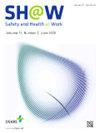Development of a Korean Safety Ladder With Ensured Overturning Stability
IF 2.9
3区 医学
Q1 PUBLIC, ENVIRONMENTAL & OCCUPATIONAL HEALTH
引用次数: 0
Abstract
Background
We have developed the Korean safety ladder as part of development of new safety technologies that can be accepted in industrial sites and would like to introduce the testing process to secure safety.
Methods
The test load and horizontal force prescribed by ANSI A14.7 and EN131-7 standards for only the overturning stability test were applied to calculate the weight required for securing overturning stability according to standards and installation of outrigger with the variables of the height of platform, the angle of inclination of the worker, and the size of the platform.
Results
The weight of a Korean safety ladder required for securing overturning stability according to the height is as follows: as mentioned by the ANSI A14.7, it is stable regardless of the weight when an outrigger. By the EN131-7 standard, a 5-step ladder is stable regardless of the weight, but 54 kg or more of weight is required for an 8-step ladder when an outrigger is installed. When there is no outrigger, 122 kg and 251 kg are required for 5-step and 8-step ladders, respectively.
Conclusion
It is necessary to restrict inclined working on the platform at less than 66° of inclination angle by the EN131-7 standards and secure 43 kg or more of weight in the minimum width of a platform of 400 mm or expand the ladder width or open length of the outrigger.
确保倾覆稳定性的韩国安全梯的开发
背景:我们开发了韩国安全梯,作为开发可在工业现场接受的新安全技术的一部分,并希望引入测试过程以确保安全。方法采用ANSI A14.7和EN131-7标准规定的仅用于倾覆稳定性试验的试验载荷和水平力,以平台高度、工人倾斜角度和平台尺寸为变量,根据标准和支腿的安装计算确保倾覆稳定性所需的重量。结果韩国安全梯根据高度确保倾覆稳定性所需的重量如下:如ANSI A14.7所述,在支腿时,无论重量如何都是稳定的。根据EN131-7标准,5级梯无论重量如何都是稳定的,但当安装支腿时,8级梯的重量必须大于等于54kg。无支腿时,5级梯需要122 kg, 8级梯需要251 kg。结论根据EN131-7标准,在倾角小于66°的平台上限制倾斜作业,在400mm平台的最小宽度内固定43 kg以上的重量或扩大梯宽或支腿的开口长度。
本文章由计算机程序翻译,如有差异,请以英文原文为准。
求助全文
约1分钟内获得全文
求助全文
来源期刊

Safety and Health at Work
Social Sciences-Safety Research
CiteScore
6.40
自引率
5.70%
发文量
1080
审稿时长
38 days
期刊介绍:
Safety and Health at Work (SH@W) is an international, peer-reviewed, interdisciplinary journal published quarterly in English beginning in 2010. The journal is aimed at providing grounds for the exchange of ideas and data developed through research experience in the broad field of occupational health and safety. Articles may deal with scientific research to improve workers'' health and safety by eliminating occupational accidents and diseases, pursuing a better working life, and creating a safe and comfortable working environment. The journal focuses primarily on original articles across the whole scope of occupational health and safety, but also welcomes up-to-date review papers and short communications and commentaries on urgent issues and case studies on unique epidemiological survey, methods of accident investigation, and analysis. High priority will be given to articles on occupational epidemiology, medicine, hygiene, toxicology, nursing and health services, work safety, ergonomics, work organization, engineering of safety (mechanical, electrical, chemical, and construction), safety management and policy, and studies related to economic evaluation and its social policy and organizational aspects. Its abbreviated title is Saf Health Work.
 求助内容:
求助内容: 应助结果提醒方式:
应助结果提醒方式:


